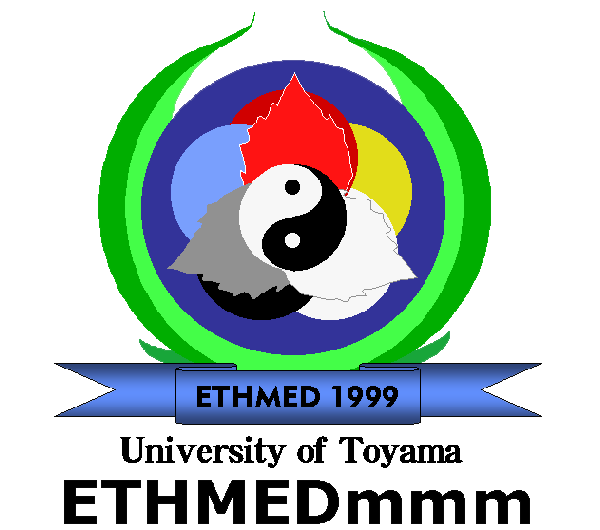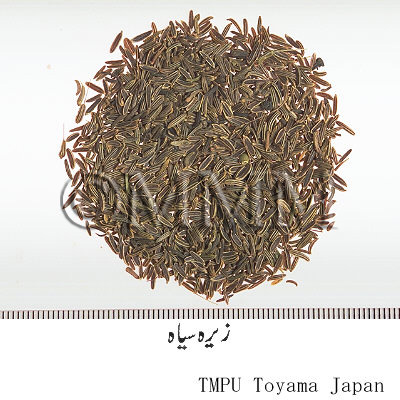Crude drug sample data base
※Click on the image to enlarge it.
The capital city, provincial capital city or the representative
location of its administrative area is indicated.
location of its administrative area is indicated.
Production area information
https://ethmed.toyama-wakan.net/img/pin_san.png
25.0700428
67.2847875
Collection information
Islamic Republic of Pakistan,Karachi [Karachi], Sind
https://ethmed.toyama-wakan.net/img/pin_nyu.png
Scientific information data base
| Crude drug name | Urudu name, English name | Zeera siyah, Caraway | ||
|---|---|---|---|---|
| Arabic name / Persian name | Karawia, Qardamana / Kammun kirmani | |||
| crude drug image |
| |||
| Original plant name | Carum carvi Linn. | |||
| Family name | Umbelliferae | |||
| Used part | Fruit (seeds) | |||
| Distribution area | A herb native to Europe and West Asia and is now cultivated in the plains as a cold season crop and in the hills of Kashmir, Kumaon, Garhwal and Chamba (India) at the altitudes of 9,000 to 12,000ft. as a summer crop. Also it is found wild in the North Himalayan regions. It is also found in Arabia. Caraway (seeds) are obtained from this plant. | |||
| Description | Good variety of Caraway is brought from India and Armenia. Caraway is also known as Kammun kirmani. The colour of the fruit is slightly blackish. It is more frequently used in medicines than Cumin. Caraway with an intense smell or a bitter pungent taste is also inferior in quality. | |||
| Function and properties | Cosmetics, Head, Eyes, Chest, Ulcers, Joints, Alimentary organs, Excretion. Aromatic, carminative and astringent, diuretic and anthelmintic, antidyspeptic and desiccant, detergent, stomachic, useful against extra moistness or catarrhs present in the stomach, distilled water (or aqua from seeds) is effective against stomach complaints as antiflatulent. | |||
| Specific actions | Carminative, stomachic, pectoral, externally desiccant and detersive. | |||
| Frequency in use | Moderate. | |||
| Common uses | Cosmetics: It is one of the rubefacient drugs possessing some liquefying potencies. Head: Its intake with water is useful in epilepsy. Eyes: The infusion of the seeds is used as eyewash which strengthens the eyesight, removes pterygium and alleviates ankyloblepharon. For this purpose the fruits are dried well over heat then finely powdered and applied as collyrium. Chest: It 'clears' the chest and relieves the cough. It is also useful in orthopneic respiration. Ulcers: If painted with vinegar it proves to be useful in scabies and ringworm. Joints: It is useful for neural diseases, phlegmatic coxalgia, paralysis and masuclar contusions. Alimentary organs: The fruits find extensive use as digestive stimulant, carminative and flavouring agent. They act as digestive tonic to produce desired peristaltic movement in the intestines and to relieve unwanted coldness in the stomach. Excretion: It is also useful for treating gripes and worm infestations including tapeworms. If taken with wine, it cures nephralgia and dysuria. In cases of renal stones (3.5gm.) of caraway is taken with the root bark of bay tree. | |||
| Side effect | Fumigation with caraway kills the foetus. Described as harmful for lungs following long duration or large dose use. Its continuous use may cause emaciation. Caraway is useful in scorpion sting and also for treating all other animal bites. | |||
| Medical system | Unani | |||
| Traditional concept | Temperament | It is hot in second and dry in the third degree. It is hot and dry in the third degree. | ||
| Drug effect | It is considered a beneficial carminative. | |||
| Dosage | 3 to 5gm. | |||
| Substitute | Kalonji (Nigella sativa Linn.), black seeds as desiccative and antiflatulent. Zeera Safaid (Cuminum cyminum Linn.), cumin in other qualities. According to Avicenna (Ibn Sina) lemon grass and Syrian rue act as substitute for caraway. | |||
| Related drugs | Fruits of Bunium persicum (Boiss.) Fedt. syn. Carum bulbocastanum Koch. as Kala Zira (black cumin) are used as substitute. The fruits of this species are larger in size (upto 7mm. long and 2mm. broad), darker in colour, semi-terete in shape and carry a heavy spicy odour. The two ventral vittae in Bunium persicum are smaller than dorsal vittae as against the seeds of Carum carvi where dorsal and ventral vittae are of the same size. | |||
| Corrigent (corrective) | Katira (Cochlospermum religiosum (L.) Alston), vinegar and other cold and moist articles. | |||
| Important compound preparations | Jawarish Kammuni, Jwarish Mastagi Kalan, Namak Sulaimani and Safuf Maghz Shirein. | |||
| References | Reference book Tips! | Glossary of Indian Medicinal Plants, 1956. Chopra, R.N., Nayar, S.L. and Chopra, I.C., Council of Scientific & Industrial Research, New Delhi. - New Edition (1996) National Institute Science Communication; Supplement p 53. Illustrated Manual of Herbal Drugs Used in Ayurveda, 1996. Sarin, Y.K., Council of Scientific & Industrial Research and Indian Council of Medical Research, New Delhi p 258. The Unani Pharmacopoeia of India, Part 1, Vol 1, 1998, Government of India, Ministry of Health & Family Welfare, Department of Indian Systems of Medicine & Homoeopathy, New Delhi. pp 92-93. National Formulary of Unani Medicine, Part 2, 1998. Government of India, ministry of Health & Family Welfare, Department of Indian Systems of Medicine & Homoeopathy, New Delhi. p 156. A Survey of Drugs, 1961 (2nd edi.). Wahid, A. K. and Siddiqui, H. H. Institute of History of Medicine and Medical Research, Delhi. pp 19-30. Dictionary of Economic Plants in India, 1996 (2nd Rep.). Singh, U; Wadhwani, A. M. and Johri B.M. Indian council of Agricultural Research, New Delhi. p 43. Al-Qanun Fil-Tibb. Avicenna. (English translation of the critical Arabic text), Book 2, 1998. Hameed, H. A. (editor), Dept. of Islamic Studies, Jamia Hamdard (Hamdard University), New Delhi. pp 359-360. Indusyunic Medicine, 1997. Usmanghani, K., Saeed, A. and Alam, M. T. Department of Pharmacognosy, Faculty of Pharmacy, University of Karachi, Karachi. pp 140-141. Unani Adwiyah Mufradah, 1984. Ali, Saifuddin, A. (3rd edi.). Taraqi-e-Urdu Bureau, R. K. Puram, New Delhi. pp 178-179. | ||
| Remarks | The drug is described by all Unani physicians. It is also included in the list of drugs used both in Unani and Ayurvedic Systems of Medicine. Fruits are used as condiment and as a flavouring agent. It is also used in various compound preparations. It is one of the most important ingredients of Garam Masala, used in curry powders. | |||
| Last renewal date | 2024/03/19 | |||


